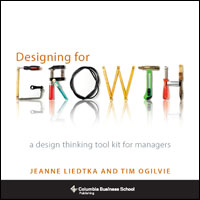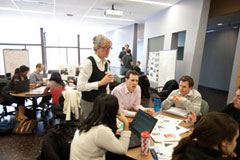What We're Reading Now
10 July 2011
Rachel started incorporating the practical advice from Designing for Growth: A Design Thinking Tool Kit for Managers by Jeanne Liedtka and Tim Ogilvie into the ways she helps clients and colleagues find the designer in all of us. (It's nice to have a resource that pulls so much good thinking into one place.)
Tags: design thinking, empathy
For years, when I've worked with people to help demystify creativity and innovation and demonstrate their vital roles in work and life, I've largely worked from a cobbled-together playbook of life lessons learned, book excerpts, and random tools pulled from a variety of sources. I like to think that when I've pulled it all together with a healthy dose of my own special sauce, I've helped a fair number of people experience the power of ideas and embrace some new ways of thinking about problem solving in their organizations. All that said, I'm excited that my job might be getting easier now that I have Designing for Growth in my arsenal.

There has been a veritable onslaught of strategy and business 'design' literature published in the past few years. Most of it is interesting but falls into one of two traps: either it's too theoretical to put into action, or it's directed to a choir of the design-familiar and leaves everyone else behind. Liedtka and Ogilvie break the mold with their new book, providing a framework and a tool kit to help almost anyone with interest and motivation explore the power of design thinking.
It starts with a relatively simple illustration. Most of the time, most of the world sees the design process as something like this:

It's messy and unpredictable and nonlinear and twisted and terribly inefficient. In many organizations, that's why design is often considered a black box so impenetrable that it's outsourced to marketers, product developers, and, well, designers. Liedtka and Ogilvie take the mess and unbundle it all into something like this:

It's still a little more convoluted than a straight line, but this starts to look more like a process that individuals and organizations can learn and replicate. When you look at it, the framework isn't all that different than a more 'traditional' approach: we study what is to make sure we understand the problems to solve and opportunities to explore, we ask what if? to generate possibilities and develop concepts, we determine what wows to kick the tires and challenge our assumptions, and we look for what works to manage risk and increase the potential for value creation.
While the steps are somewhat familiar, the recommended approaches in each phase sound reasonable but are more challenging for most people to put into practice. (Try explaining to a typical business planner that you're going to generate new business offerings based on research you conduct with a dozen or so customers, and you'll see what I mean.) Lucky for all of us, Designing for Growth provides concrete tools and step-by-step instructions and plenty of real-life examples for each step of the journey so that there's sufficient structure to help the reader navigate the discomfort of trying something new. Meanwhile, the structure is clear enough that it provides a sturdy architecture from which to hang all those tidbits and other tools I've been collecting for the past many years.

I've been fortunate enough to collaborate with Liedtka and help explore new ways to bring this material into the MBA and Executive Education classrooms at Darden. She's fond of saying that she's not a designer, and that if she and the rest of the Darden faculty can make good use of the Designing for Growth tools then anyone can. Having been in her classroom as both student and colleague, I'd say she's more of a designer than she'd like to admit, though perhaps not in a traditional sense. Because for me — and as illustrated throughout Designing for Growth — being a designer isn't about being artistic or clever or even all that creative. Being a designer is about approaching a complex problem with curiosity and empathy and patience and then having the discipline to explore many possible answers before selecting a path forward. Sounds like the business school case method to me . . . and if it works for helping so many of us learn about business, maybe it will help all of us actually do business better.







Comments
Our Comment Policy:
Our blog posts are only half of the conversation. What our readers have to say is equally important to us, and we're grateful for all the comments that continue the dialog.
To ensure that the discussion here is as useful as possible to all of our readers, please be respectful of our contributors and refrain from harassing, threatening and/or vulgar language. We reserve the right to screen and remove any comments from the site. If you have a question about a comment or want to discuss our policy, please contact us. We'll talk it over.
There are no comments for this entry yet.